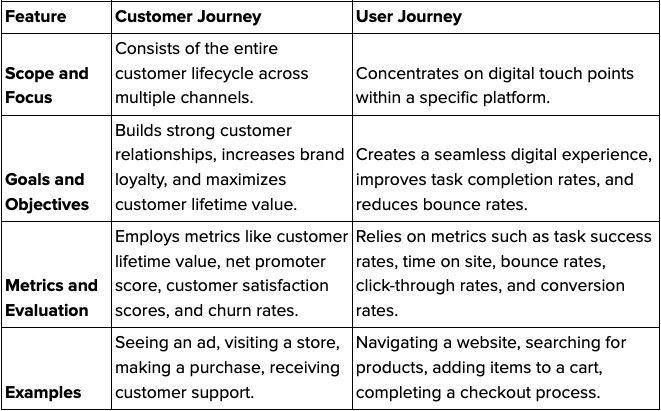Understanding the path a customer takes from initial awareness to post-purchase loyalty is crucial for businesses aiming to thrive. However, equally important is the digital journey a user undertakes. And these concepts are not exactly the same. Let's dissect the differences between these two concepts and explore how to optimize them for business success.
Defining the Two Journeys
The customer journey is a comprehensive roadmap of a customer's interactions with a brand. It begins with the initial discovery of the brand and extends through every subsequent touchpoint, both online and offline. Everything from seeing an advertisement, visiting a physical store, making a purchase, seeking customer support, and any other interaction with the company.
The ultimate goal of understanding the customer journey is to cultivate long-term customer retention. By mapping out these interactions, businesses can identify opportunities to enhance the customer experience, increase satisfaction, and ultimately, maximize the overall value a customer brings to the company over their lifetime.
The user journey is a more focused view of a customer's experience, specifically within the digital realm. It outlines the steps a person takes while interacting with a particular digital platform, such as a website or mobile app. This includes how they navigate the interface, complete tasks, and consume content.
The primary objective of the user journey is to optimize the digital experience. By analyzing how users interact with a platform, businesses can identify areas for improvement, enhance usability, and increase overall user satisfaction. A positive user experience contributes to a unified customer experience.
Key Differences

While both journeys contribute to overall customer satisfaction, they have distinct characteristics.
Scope and Focus
Customer Journey: Consists of the entire customer lifecycle, from initial awareness to post-purchase support. It considers multiple channels, including physical stores, online platforms, customer service interactions, and marketing campaigns.
User Journey: Concentrates solely on the digital touchpoints within a specific platform. It examines how users interact with the interface, complete tasks, and navigate through the digital space.
Goals and Objectives
Customer Journey: Seeks to build strong customer relationships, increase brand loyalty, and drive repeat business. The ultimate aim is to maximize customer lifetime value.
User Journey: Focuses on creating a seamless and enjoyable digital experience. It aims to increase user satisfaction, improve task completion rates, and reduce bounce rates.
Metrics and Evaluation
Customer Journey: Employs metrics like customer lifetime value, net promoter score, customer satisfaction scores, and churn rates to measure success.
User Journey: Relies on metrics such as task success rates, time on site, bounce rates, click-through rates, and conversion rates to assess performance.
For easier referral, we have compiled the key differences in a table below.

Optimizing the Journeys

Effective optimization of both customer and user journeys is essential for business growth. Here are some key strategies.
Prioritize the First Impression
Customer Journey: Establish a strong brand identity that is consistently reflected across all touchpoints, from advertising to in-store experiences, creating a cohesive and memorable brand image.
User Journey: Design a visually appealing and intuitive website or app interface that loads swiftly. The initial moments of interaction are crucial for capturing user attention and creating a positive first impression.
Streamline the Experience
Customer Journey: Identify and eliminate any obstacles or friction points that hinder the customer's journey. Ensure seamless transitions between different channels (online, offline, mobile) and provide consistent, helpful support throughout the process and create a unified customer experience.
User Journey: Simplify navigation within the digital platform, reducing the number of steps required to complete tasks. Optimize page load times to minimize user frustration and improve overall experience.
Personalize the Interaction
Customer Journey: Use customer data to deliver tailored experiences. Offer personalized recommendations, promotions, and content based on individual preferences and behaviors.
User Journey: Implement personalization features within the digital platform to display relevant content and product suggestions based on user history and actions.
Measure and Iterate
Customer Journey: Continuously gather feedback from customers through surveys, reviews, and social media. Analyze customer data to identify trends, pain points, and areas for improvement.
User Journey: Conduct usability tests to evaluate the effectiveness of the user interface. Track KPIs to measure user behavior and identify opportunities for optimization. Use data-driven insights to make informed changes to the platform.
Leverage Technology
Customer Journey: Utilize customer relationship management (CRM) systems to manage customer interactions, track customer data, and gain valuable insights into customer behavior.
User Journey: Employ analytics tools to gather data on user behavior, preferences, and interactions within the digital platform. Use these insights to optimize the user experience and drive conversions.
Optimizing Both User And Customer Journey

While the customer journey and user journey may seem distinct, they are interconnected. By optimizing both, businesses can create exceptional experiences that drive customer and business growth. By understanding the nuances between these two concepts and implementing effective strategies, organizations can build lasting relationships with their customers and achieve a unified customer experience.
If you’d like a helping hand when it comes to marketing, CX and marketing automation, Omind is your answer. Omind leverages AI to bring to you a conversational platform that helps visitors engage with your business and turns visitors into paying customers. To see how our platform works, schedule a demo today.
AUTHOR
Team Omind
Empowering Businesses with Unified Customer Experience Platform, Leveraging Advanced AI and Intelligent Automation
PRODUCT
Unified CXM
Share LINK
Related Blogs




